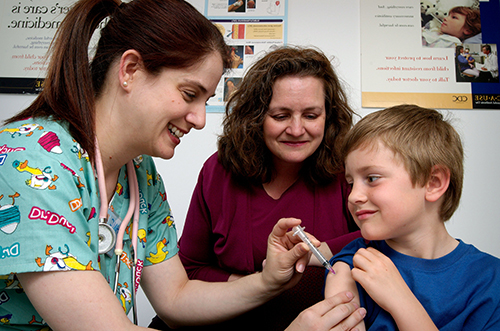As I write this in mid-October 2021 we are anticipating a ramping up of COVID-19 case numbers in paediatrics. I am on call today and as I look down my list of patients I see I have around 30 COVID-19 positive children in the community on the books, hopefully essentially well at home and receiving a daily phone call from the Hospital in the Home team here at Lismore Base Hospital.
We anticipate this number will rise into the hundreds over the next month or two and then hopefully fall. The vast majority of them will have symptoms of a cold or less and will have contracted the disease from their parents.
We do not know why children under twelve have such mild disease, and adolescents have only mild respiratory or gastrointestinal symptoms. Perhaps it is because it is a coronavirus, like the common cold, and children and adolescents are primed by this very frequently, like Jenner’s milkmaids with their cowpox.
What is known is that children are underrepresented in terms of known COVID-19 cases, which probably means we’re not testing them because they are well, even when they have the virus. As with adults, it is only the children with at least moderate comorbidities who seem to have any chance of becoming unwell or even to die. They do not pass it on very effectively either, so they behave as a vaccinated adult.
Where COVID-19 does matter in paediatrics is during pregnancies and after delivery. The incidence of premature birth, mainly due to spontaneous labour but also to induction of labour if a baby is exhibiting signs of distress in the womb, is 40% higher in mothers who are infected and unwell. As with the adult population the presence of comorbidities in the mother, such as obesity, hypertension and diabetes,will significantly increase the risk of premature birth. Cases of premature birth from 26 weeks on are being recorded, though with most in the 32 to 37 week range.
In pregnancy there is no vertical transmission of the virus, so babies are born without COVID-19, although they can easily pick it up from their parents the moment they are handled. Breastmilk does not contain COVID-19 and if parents use the usual precautions of wearing a mask and washing their hands there is a high likelihood the babies will not become infected, though even if they do they will almost certainly be asymptomatic.
So as I look through my list of COVID-19 children I think, ‘will many come into hospital’? Probably not. Symptoms of gastroenteritis will be the likely culprit, rather than respiratory, as the inflammatory reaction seen in adults is exceedingly rare. Given children under twelve have particularly mild disease if they do contract the virus, it begs the question as to whether they need to be vaccinated. Whilst I cannot see it written anywhere, my suspicion is that the drive to vaccinate young children in countries such as America and India is mainly due to the fact they cannot gain traction in the adult community to achieve full vaccination.
It comes down to vaccination in the end. If the adults are vaccinated in sufficient numbers, children do not need to be vaccinated. It is a discussion for another day as to why people are choosing to not be vaccinated.
And spare a thought for the children as they enter a post COVID-19 world. The warping of our whole society has seen a stutter in the acquisition of skills and learning, house prices soaring and most importantly for them a social vacuum developing around meeting partners and laying down that social bedrock young people need to confidently and successfully enter the world.
There is talk about Australia and New Zealand having a social fabric which has withstood a formidable foe in COVID-19, enabling the pandemic to wash over us when we are nearly fully vaccinated. Whilst this is fundamentally true, and something I personally am extremely proud of, it is ultimately a gift from the young to the old, and this should never be forgotten. Our parents and grandparents can die with their families around them to comfort them, at a time and place when they are ready to go. Let’s all return that generosity over the next few decades.
















